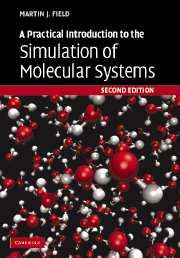Book contents
- Frontmatter
- Contents
- Preface to the first edition
- Preface to the second edition
- 1 Preliminaries
- 2 Chemical models and representations
- 3 Coordinates and coordinate manipulations
- 4 Quantum chemical models
- 5 Molecular mechanics
- 6 Hybrid potentials
- 7 Finding stationary points and reaction paths on potential energy surfaces
- 8 Normal mode analysis
- 9 Molecular dynamics simulations I
- 10 More on non-bonding interactions
- 11 Molecular dynamics simulations II
- 12 Monte Carlo simulations
- Appendix 1 The pDynamo library
- Appendix 2 Mathematical appendix
- Appendix 3 Solvent boxes and solvated molecules
- Bibliography
- Author index
- Subject index
9 - Molecular dynamics simulations I
Published online by Cambridge University Press: 03 December 2009
- Frontmatter
- Contents
- Preface to the first edition
- Preface to the second edition
- 1 Preliminaries
- 2 Chemical models and representations
- 3 Coordinates and coordinate manipulations
- 4 Quantum chemical models
- 5 Molecular mechanics
- 6 Hybrid potentials
- 7 Finding stationary points and reaction paths on potential energy surfaces
- 8 Normal mode analysis
- 9 Molecular dynamics simulations I
- 10 More on non-bonding interactions
- 11 Molecular dynamics simulations II
- 12 Monte Carlo simulations
- Appendix 1 The pDynamo library
- Appendix 2 Mathematical appendix
- Appendix 3 Solvent boxes and solvated molecules
- Bibliography
- Author index
- Subject index
Summary
Introduction
We saw in Chapter 7 how it was possible to explore relatively small parts of a potential energy surface and in Chapter 8 how to use some of this information to obtain approximate dynamical and thermodynamic information about a system. These methods, though, are local – they consider only a limited portion of the potential energy surface and the dynamics of the system within it. It is possible to go beyond these ‘static’ approximations to study the dynamics of a system directly. Some of these techniques will be introduced in the present chapter.
Molecular dynamics
As we discussed in Chapter 4, complete knowledge of the behaviour of a system can be obtained, in principle, by solving its time-dependent Schrödinger equation (Equation (4.1)), which governs the dynamics of all the particles in the system, both electrons and nuclei. To progress in the solution of this equation we introduced the Born–Oppenheimer approximation, which allows the electronic and the nuclear problems to be treated separately. This separation leads to the concept of a potential energy surface, which is the effective potential that the nuclei experience once the electronic problem has been solved. In principle, it is possible to study the dynamics of the nuclei under the influence of the effective electronic potential using an equivalent equation to Equation (4.1) but for the nuclei only. This can be done for systems consisting of a very small number of particles but proves impractical otherwise.
Fortunately, whereas it is difficult or impossible to study the dynamics of the system quantum mechanically, a classical dynamical study is relatively straightforward and provides much useful information.
Information
- Type
- Chapter
- Information
- A Practical Introduction to the Simulation of Molecular Systems , pp. 170 - 194Publisher: Cambridge University PressPrint publication year: 2007
